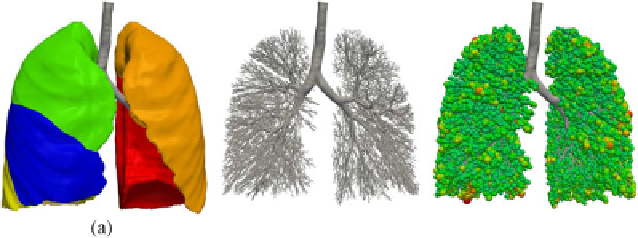Biomedical Engineering Reference
In-Depth Information
Fig. 28.4
Generation of 0D lung models. (
a
) Lobes segmented from CT images. (
b
) Space-filling
airway tree generated within the lobes. (
c
) Acini generated within the lobes
28.3 Reduced-Dimensional Lung Model
An effective alternative to 3D lung models are reduced-dimensional models such
as 1D, 0D, and impedance models. Corresponding approaches are generally based
on electrical analogies, where flow resistance, fluid inertia, and tissue compli-
ance are represented by resistors, inductors, and capacitors, respectively. Reduced-
dimensional models were shown to well capture the averaged physiological and
physical behavior of lung mechanics (Pedley et al.,
1970
; Horsfield et al.,
1971
;
Lambert et al.,
1982
; Bates,
2009
; Comerford et al.,
2010
;Ismailetal.,
2012a
).
To enable the spatial representation of flow in the lung, our reduced-dimensional
model is based on patient-specific CT images and morphological information for
the unresolvable generations (cf. Fig.
28.4
). We utilize a methodology similar to
the one presented by Tawhai et al. (
2000
) to generate a space-filling tree of 0D air-
ways. With each terminal airway, the volume of a so-called acinus representing a
cluster of alveolar ducts is associated. In the following, the building blocks of our
reduced-dimensional lung model will be briefly reviewed.
28.3.1 Tree of 0D Airways
Following Pedley et al. (
1970
) and van Ertbruggen et al. (
2005
), we model the air-
way tree as a combination of pipes with nonlinear resistances. Pre-integration in
radial as well as longitudinal direction leads to a 0D model of the individual seg-
ments which are then combined to an overall model. To validate our approach, we
compared the results obtained in fully 0D and coupled 3D-0D simulations (Ismail et
al.,
2012a
). To create the 3D-0D model, we coupled a 3D airway model segmented
from CT scans with a space-filling tree of 0D airways for the lower generations (cf.
also Sect.
28.3.3
). The results shown in Fig.
28.5
demonstrate that the 0D model can
indeed mimic the space-averaged 3D results.



